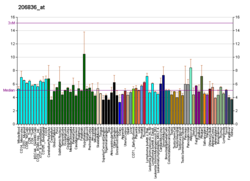Dopaminski transporter (ili dopaminski aktivni transporter, DAT, SLC6A3) je transmembranski protein koji pumpa neurotransmiter dopamin iz sinaptičkog rascepa nazad u citozol. U citosolu, drugi transporteri sekvestriraju dopamin u vezikule za čuvanje i kasnije otpuštanje. Ponovni unos dopamina pomoću DAT pruža primarni mehanizam putem koga se dopamin uklanja iz sinapsi, mada mogu da postoje izuzeci u prefrontalnom korteksu, gde evidencija ukazuje na mogućnost veće uloge norepinefrinskog transportera.[1]
DAT je impliciran u brojnim poremećajima vezanim za dopamin, među kojima su attention deficit hyperactivity disorder, bipolar disorder, clinical depression, and alcoholism. The gene that encodes the DAT protein is located on human chromosome 5, consists of 15 coding exons, and is roughly 64 kbp long. Evidence for the associations between DAT and dopamine related disorders has come from a type of genetic polymorphism, known as a VNTR, in the DAT gene (DAT1), which influences the amount of protein expressed.[2]
Funkcija
DAT is an integral membrane protein that removes dopamine from the synaptic cleft and deposits it into surrounding cells, thus terminating the signal of the neurotransmitter. Dopamine underlies several aspects of cognition, including reward, and DAT facilitates regulation of that signal.[3]
Mehanizam
DAT is a symporter that moves dopamine across the cell membrane by coupling the movement to the energetically-favorable movement of sodium ions moving from high to low concentration into the cell. DAT function requires the sequential binding and co-transport of two Na+ ions and one Cl− ion with the dopamine substrate. The driving force for DAT-mediated dopamine reuptake is the ion concentration gradient generated by the plasma membrane Na+/K+ ATPase.[4]
In the most widely accepted model for monoamine transporter function, sodium ions must bind to the extracellular domain of the transporter before dopamine can bind. Once dopamine binds, the protein undergoes a conformational change, which allows both sodium and dopamine to unbind on the intracellular side of the membrane.[5]
Studies using electrophysiology and radioactive-labeled dopamine have confirmed that the dopamine transporter is similar to other monoamine transporters in that one molecule of neurotransmitter can be transported across the membrane with one or two sodium ions. Chloride ions are also needed to prevent a buildup of positive charge. These studies have also shown that transport rate and direction is totally dependent on the sodium gradient.[6]
Because of the tight coupling of the membrane potential and the sodium gradient, activity-induced changes in membrane polarity can dramatically influence transport rates. In addition, the transporter may contribute to dopamine release when the neuron depolarizes.[6]
Interakcije
Dopaminski transporter formira interakcije sa:
Osim ovih urođenih protein-protein interakcija, nedavne studije su demonstrirale da viralni proteini kao što je HIV-1 Tat protein formiraju interakcije sa DAT[11][12] i to vezivanje može da poremeti domapinsku homeostazu kod HIV pozitivnih osoba, što doprinosi neurokognitivnim premećajima vezanim za HIV.[13]
Vidi još
Reference
- ^ Carboni E, Tanda GL, Frau R, Di Chiara G (1990). „Blockade of the noradrenaline carrier increases extracellular dopamine concentrations in the prefrontal cortex: evidence that dopamine is taken up in vivo by noradrenergic terminals”. J. Neurochem. 55 (3): 1067—70. PMID 2117046. doi:10.1111/j.1471-4159.1990.tb04599.x.
- ^ Vandenbergh DJ, Persico AM, Hawkins AL, Griffin CA, Li X, Jabs EW, Uhl GR (1992). „Human dopamine transporter gene (DAT1) maps to chromosome 5p15.3 and displays a VNTR”. Genomics. 14 (4): 1104—6. PMID 1478653. doi:10.1016/S0888-7543(05)80138-7.
- ^ Schultz W (1998). „Predictive reward signal of dopamine neurons”. J. Neurophysiol. 80 (1): 1—27. PMID 9658025.
- ^ Torres GE, Gainetdinov RR, Caron MG (2003). „Plasma membrane monoamine transporters: structure, regulation and function”. Nat. Rev. Neurosci. 4 (1): 13—25. PMID 12511858. doi:10.1038/nrn1008.
- ^ Sonders MS, Zhu SJ, Zahniser NR, Kavanaugh MP, Amara SG (1997). „Multiple ionic conductances of the human dopamine transporter: the actions of dopamine and psychostimulants”. J. Neurosci. 17 (3): 960—74. PMID 8994051.
- ^ а б Wheeler DD, Edwards AM, Chapman BM, Ondo JG (1993). „A model of the sodium dependence of dopamine uptake in rat striatal synaptosomes”. Neurochem. Res. 18 (8): 927—936. PMID 8371835. doi:10.1007/BF00998279.
- ^ Wersinger C, Sidhu A (2003). „Attenuation of dopamine transporter activity by alpha-synuclein”. Neurosci. Lett. 340 (3): 189—92. PMID 12672538. doi:10.1016/S0304-3940(03)00097-1.
- ^ Lee FJ, Liu F, Pristupa ZB, Niznik HB (2001). „Direct binding and functional coupling of alpha-synuclein to the dopamine transporters accelerate dopamine-induced apoptosis”. FASEB J. 15 (6): 916—26. PMID 11292651. doi:10.1096/fj.00-0334com.
- ^ Torres GE, Yao WD, Mohn AR, Quan H, Kim KM, Levey AI, Staudinger J, Caron MG (2001). „Functional interaction between monoamine plasma membrane transporters and the synaptic PDZ domain-containing protein PICK1”. Neuron. 30 (1): 121—34. PMID 11343649. doi:10.1016/S0896-6273(01)00267-7.
- ^ Carneiro AM, Ingram SL, Beaulieu JM, Sweeney A, Amara SG, Thomas SM, Caron MG, Torres GE (2002). „The multiple LIM domain-containing adaptor protein Hic-5 synaptically colocalizes and interacts with the dopamine transporter”. J. Neurosci. 22 (16): 7045—54. PMID 12177201.
- ^ Midde, Narasimha M.; Yuan, Yaxia; Quizon, Pamela M.; Sun, Wei-Lun; Huang, Xiaoqin; Zhan, Chang-Guo; Zhu, Jun (2015-03-01). „Mutations at tyrosine 88, lysine 92 and tyrosine 470 of human dopamine transporter result in an attenuation of HIV-1 Tat-induced inhibition of dopamine transport”. Journal of Neuroimmune Pharmacology. 10 (1): 122—135. ISSN 1557-1904. PMC 4388869
 . PMID 25604666. doi:10.1007/s11481-015-9583-3.
. PMID 25604666. doi:10.1007/s11481-015-9583-3.
- ^ Midde, Narasimha M.; Huang, Xiaoqin; Gomez, Adrian M.; Booze, Rosemarie M.; Zhan, Chang-Guo; Zhu, Jun (2013-09-01). „Mutation of tyrosine 470 of human dopamine transporter is critical for HIV-1 Tat-induced inhibition of dopamine transport and transporter conformational transitions”. Journal of Neuroimmune Pharmacology. 8 (4): 975—987. ISSN 1557-1904. PMC 3740080
 . PMID 23645138. doi:10.1007/s11481-013-9464-6.
. PMID 23645138. doi:10.1007/s11481-013-9464-6.
- ^ Purohit, Vishnudutt; Rapaka, Rao; Shurtleff, David (2011-08-01). „Drugs of abuse, dopamine, and HIV-associated neurocognitive disorders/HIV-associated dementia”. Molecular Neurobiology. 44 (1): 102—110. ISSN 1559-1182. PMID 21717292. doi:10.1007/s12035-011-8195-z.
Spoljašnje veze
 . PMID 25604666. doi:10.1007/s11481-015-9583-3.
. PMID 25604666. doi:10.1007/s11481-015-9583-3.
 . PMID 23645138. doi:10.1007/s11481-013-9464-6.
. PMID 23645138. doi:10.1007/s11481-013-9464-6.

